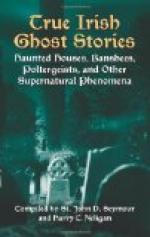Very different descriptions are given of her personal appearance. Sometimes she is young and beautiful, sometimes old and of a fearsome appearance. One writer describes her as “a tall, thin woman with uncovered head, and long hair that floated round her shoulders, attired in something which seemed either a loose white cloak, or a sheet thrown hastily around her, uttering piercing cries.” Another person, a coachman, saw her one evening sitting on a stile in the yard; she seemed to be a very small woman, with blue eyes, long light hair, and wearing a red cloak. Other descriptions will be found in this chapter. By the way, it does not seem to be true that the Banshee exclusively follows families of Irish descent, for the last incident had reference to the death of a member of a Co. Galway family English by name and origin.
One of the oldest and best-known Banshee stories is that related in the Memoirs of Lady Fanshaw.[9] In 1642 her husband, Sir Richard, and she chanced to visit a friend, the head of an Irish sept, who resided in his ancient baronial castle, surrounded with a moat. At midnight she was awakened by a ghastly and supernatural scream, and looking out of bed, beheld in the moonlight a female face and part of the form hovering at the window. The distance from the ground, as well as the circumstance of the moat, excluded the possibility that what she beheld was of this world. The face was that of a young and rather handsome woman, but pale, and the hair, which was reddish, was loose and dishevelled. The dress, which Lady Fanshaw’s terror did not prevent her remarking accurately, was that of the ancient Irish. This apparition continued to exhibit itself for some time, and then vanished with two shrieks similar to that which had first excited Lady Fanshaw’s attention. In the morning, with infinite terror, she communicated to her host what she had witnessed, and found him prepared not only to credit, but to account for the superstition. “A near relation of my family,” said he, “expired last night in this castle. We disguised our certain expectation of the event from you, lest it should throw a cloud over the cheerful reception which was your due. Now, before such




